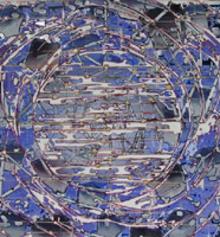
Sarah Walker
Perihelion II, 2003
acrylic on paper on aluminum, 24 x 23 in.

It's an airplane, it's a piece of furniture, it's a telephone - no, it's... well, we don't know exactly. The work in the Gregory Lind Gallery's new exhibit "Closer Than You Think" marks the collusive terrain of timeless fantasy, implied shapes, distorted topographies and optical illusions. This is the kind of art that brings to mind the scientific paradox of observation and calculation- an image is constantly in flux and the mere act of translating it from brain to canvas, canvas to spectator, indicates its appetite for change and motion.
Featuring artists Jim Gaylord, Robert Gutierrez, Seth Koen, Bob Matthews, Christian Maychack, Mel Prest, Duane Slick, Jonathan Tucker, and Sarah Walker, the exhibit presents a range of work in widely divergent media, from acrylic to watercolor to gouache to chicken wire and foamcore. Most of the work is minimalistic and monochromatic on first appearance, but has a tendency to morph before one's very eyes from unusual to tangible. Peculiar hues and gravity-defying arrangements populate the exhibit, but the works are like pictures within pictures. The effect is that the longer you look, the more you can recognize various objects, ideas, and symbols-all hewn together in an elaborate tapestry of our collective fears, fetishes, and loves. "Closer Than You Think" is prone to leaps of the imagination, and the art usually triggers a stream of associations and ideas in the viewer's mind-a vague doodle on closer inspection becomes a pill capsule or a planet, before morphing into something else.
Form and texture create a delicate interplay in the work of Mel Prest, who uses lines, ripples, and indentations sparingly in his mapping of optical topographies, while Sarah Walker's surface-scratched paintings are like intricate mathematical designs mapped onto dazzling bursts of color.
Jonathan Tucker's "Column", composed of stone-like objects perched on the wall, takes the viewer into an organic candyland of speckled eggs and hidden treasure. His near-garish colors and whimsical texturing bring to mind a childlike sensibility for art that's pleasing to both the eyes and hands.
Following closely on Tucker's theme, Christian Maychack delivers a perplexing and evocative mixture of tangible forms and bizarre abstractions-his "A Model of Self-Sufficiency" is an anthropomorphic construction of cornice molding, acrylic, chicken wire, and foamcore. Maychack is fixated on the object in progress, and his art contains the same suggestion of movement as the familiar clay blobs of stop-motion animation. His work is a complex commentary on the culture of objects, from whittled body parts to furniture that toes a line between functionality and personality.
It's easy to pigeonhole "contemporary" art as derivative or too abstract, but "Closer Than You Think" is a diverse celebration of the very boundaries of craft. The exhibit appeals to a primitive fascination with creating visions from other senses, like taste or touch. And just as the work leaps from sense to sense, it maintains a certain malleability with its constant exchange between the familiar and unfamiliar.